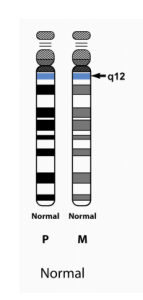Symptoms of Angelman syndrome
Some symptoms can vary and be more severe than others, but in most children diagnosed with AS, the following are present:
Developmental delays. These can vary from individual to individual , but common delays are:
Infants (0-24 months): inability to support one’s head, pull oneself up to stand and delayed motor skills like crawling. Feeding issues due to problems sucking or swallowing. Young children: Delayed ability to walk and an unstable gait or balance issues.
Seizures. Usually begin to occur between 18 months – 3 years old
A happy demeanor. Frequent laughing, smiling and easily excitable
Sleep problems. Abnormal sleep-wake cycles and diminished need for sleep
Lack of speech. Infants display lack of cooing or babbling; young children usually use nonverbal methods of communication because conversational speech is either absent or limited to very few words
What Causes Angelman Syndrome
Humans have 46 chromosomes inside every cell in their body. We receive 23 chromosomes from our mother and 23 from our father. Different genes are located in each chromosome. The Angelman syndrome gene, UBE3A, is located at chromosome 15.
Some genes on the chromosome are turned on or expressed and others are turned off or silent. In typical humans, the UBE3A gene from our father is silent and the UBE3A gene from our mother helps our brain develop. However, in individuals with Angelman syndrome, there is a problem with the UBE3A gene from the mother and the brain cannot get the information it needs to develop and control speech, movement and learning. All of this action in the chromosomes takes place during fetal development, and thus is part of a person’s genetic makeup.
When the UBE3A gene does not function normally, the individual has Angelman syndrome. Scientists around the world, are studying the UBE3A gene and trying to find ways to turn on or unsilence the copy from the father.
See information on testing and diagnosis of Angelman syndrome.






